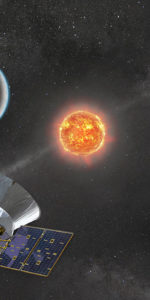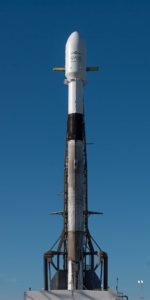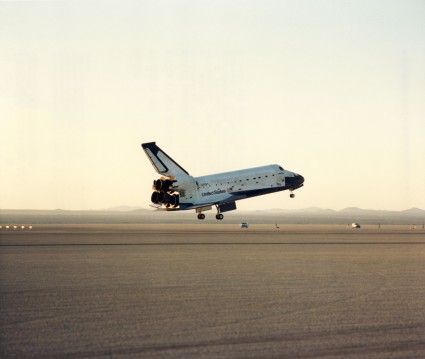
Columbia touches down at Edwards Air Force Base, Calif., on 13 August 1989, to wrap up her first mission after the Challenger tragedy. Photo Credit: NASA
Astronaut Dick Richards was five weeks from his first launch into space when the Challenger disaster snatched the opportunity from him. In January 1985, Richards had been named as veteran astronaut Jon McBride’s pilot on STS-61E, the ASTRO-1 science mission, scheduled for March 1986 to observe Halley’s Comet and a multitude of other astronomical targets. When Challenger rose from Pad 39B at the Kennedy Space Center (KSC) in Florida on 28 January 1986, McBride and Richards were in their seats in the simulator at the Johnson Space Center (JSC) in Houston, Texas, working launch-abort scenarios. They paused briefly to step outside and watch Challenger’s launch. Seventy-three seconds later, STS-61E vanished from the manifest like a blip from a radar screen. Thirty years ago, this month, Richards and another crew—that of STS-28—finally made it to space, on a quite different mission, and in a profoundly different shuttle era.
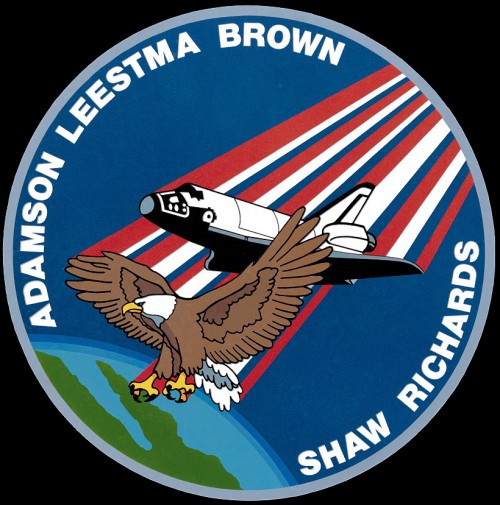
Many of the classified shuttle missions included similar motifs on their official crew patches: the American Eagle and the patriotic red, white and blue of the U.S. flag. The surnames of the STS-28 crew are visible around the perimeter. Image Credit: NASA
By tragic irony, the careers of Richards and Challenger’s pilot, Mike Smith, were entwined in many ways. For starters, they were the only two Navy pilots selected by NASA in its May 1980 astronaut class and both would go on to be assigned their first missions at the same time; Smith was paired with veteran shuttle pilot Dick Scobee and Richards with seasoned astronaut McBride. At first, it seemed to Richards that the pairings might happen the other way around. “I started getting all these simulation flights with Dick Scobee,” he remembered in his NASA oral history interview. Then, a few weeks later, Smith started doing simulations with Scobee and Richards began working extensively with McBride. Years later, Richards believed that delays to the long-awaited first shuttle launch from Vandenberg Air Force Base, Calif., may have led to the decision. It would certainly be ironic to suppose that a simple quirk of fate and timing might have kept Richards from losing his life on Challenger’s final mission.
In February 1988, he was formally assigned to pilot STS-28, a classified mission for the Department of Defense and the return-to-flight of shuttle Columbia. The crew that he would be joining had actually been assigned to STS-61N in December 1985, although the pilot for that flight, Mike McCulley, was substituted for Richards. Commander Brewster Shaw would be joined by mission specialists Jim Adamson, Dave Leestma and Mark Brown. But with pressure on getting Columbia’s sister shuttles—Discovery and Atlantis—flown before the end of 1988, STS-28 found itself last in the queue and launch was repeatedly postponed until the summer of the following year. A curtain of military secrecy enshrouded the mission and it was not until much later that a few details of what Shaw and his men did during their five days in space began to trickle out.
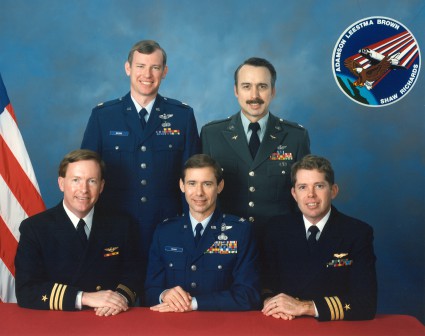
The STS-28 crew reflected no fewer than three of the armed services: Air Force commander Brewster Shaw (seated, centre) is flanked by Navy officers Dick Richards (left) and Dave Leestma. Standing are Air Force engineer Mark Brown (left) and Army officer Jim Adamson. Photo Credit: NASA
Leestma described preparations for these top-secret missions as unusual and very cloak-and-dagger in nature. “Sometimes you had to disguise where you were going,” he said. “You’d file a flight plan in a T-38 [for] one place and go somewhere else, to try to not leave a trail for where you were going or what you were doing, who was the sponsor of this payload or what its capabilities were or what it was going to do. You had to be careful, all the time, of what you were saying.” STS-28 would transport the Department of Defense’s fourth major shuttle payload into orbit, but in the wake of Challenger the U.S. intelligence community began to reduce its reliance on the reusable fleet of orbiters by reverting to expendable boosters. Only payloads which were too large, too heavy or too awkward to be reconfigured for an expendable launch remained on the shuttle. “The DoD did not like dealing with NASA,” said Leestma. “It was a constrained arrangement, but it worked very well and the DoD was happy with the product that they got in the end.”
It had long since become standard practice in the build-up to such missions that the countdown was conducted in almost complete secrecy, with the public affairs commentary starting when Columbia emerged from the T-9 minute hold. Only after this point were the gathered spectators able to listen in to clipped intercom exchanges between the crew and launch controllers. A software problem caused the clock to be held for longer than planned, and a combination of haze and fog over the Shuttle Landing Facility (SLF) meant that STS-28 set off 40 minutes late at 8:37 a.m. EDT on 8 August 1989. Watching from the VIP area was NASA Deputy Administrator J.R. Thompson, who declared “We’re off to a good start on this mission.”
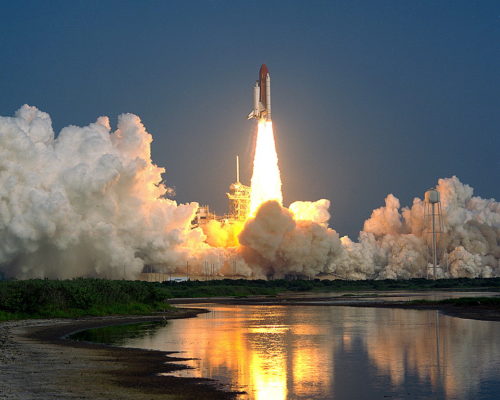
Columbia rises from Pad 39B on 8 August 1989. Photo Credit: NASA
Considering that the flight was historic, as the space agency’s flagship orbiter spread her wings once again, the official announcement from spokesman Brian Welch was flat and businesslike: Two hours after launch, he said, Shaw’s crew had been given a “Go” for orbital operations.
That was it.
The next five days would be similarly shrouded in secrecy and rumor.
The second part of this article will appear next weekend.
.
.
FOLLOW AmericaSpace on Facebook and Twitter!
.
.




